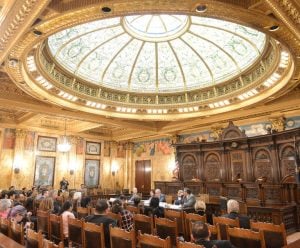The Court of Appeals almost never reverses a criminal conviction on the basis that the trial court did not properly conduct voir dire in assessing the suitability of potential jurors to sit in the cases. The trial judge enjoys substantial discretion in managing this phase of the trial. But in this case the Second Circuit reverses because the judge did not ask questions that would determine if potential jurors held any preconcieved notions about criminal gangs.
The case is United States v. Nieves, issued on January 26. Defendant was convicted of witness intimidation. As this case involves gang members, defendant's lawyer wanted Judge Rakoff to ask potential jurors for bias against gang members. Judge Rakoff declined that request and instead mostly asked where the potential jurors lived, whether they have a significant other and if so what their loved one does for a living. Like other judges, the trial judge here also asked potential jurors about their kids. Voir dire in federal court is usually brief and does not tell the trial lawyers much about the jurors who will hear the case. The trial court said it does not ask "attitudinal questions" that might invade anyone's privacy during voir dire. But again, convictions are almost never overturned on the basis of faulty voir dire.
I note that Judge Rakoff also said on the record that he will not ask potential jurors questions about whether they read the New York Times or what is their favorite newspaper, as these questions also intrude on juror privacy. Other judges have asked questions like this in my experience and they give is a better sense of who the potential juror is. Questions about news sources and political opinions are not part of the Second Circuit's holding in this case.
As cursory as voir dire frequently is, trial judges are required to screen potential jurors for bias. The Court (Lynch, Lee and Robinson) writes, "It is within a judge’s discretion to decide whether or not to ask questions that elicit jurors’ general attitudes about political or social questions, permitting counsel to speculate about jurors’ reactions to the evidence in a case when allocating their peremptory challenges. But where the “attitude” in question is a bias or predisposition for or against one side or the other, and particularly where key evidence targets the subject of that bias or predisposition, it is the judge’s responsibility to make some inquiry. Prospective jurors have no right to keep those attitudes private."
The Second Circuit breaks new ground in this case in holding that Judge Rakoff should have inquired about potential juror bias about gangs. The Court holds that "(1) prejudice against people associated with gangs represented a pervasive bias relevant to a key dynamic likely to arise at trial, and (2) the district court neglected to 'inquire about, or warn against,' that bias." In support of this holding, Judge Lynch (an expert on criminal law) noted that news reports at the time of this trial focused on a recent spike in violent crime that law enforcement had attributed to gang violence. That increased the risk of prejudice against gang members among prospective jurors.
This holding is rare, but it will not lead to more conviction reversals in other voir dire challenges. The panel says this may be the first time the Court has ever reversed a conviction on this basis. What this case does is require trial judges to ask more questions about potential juror bias against gang members in gang cases.




